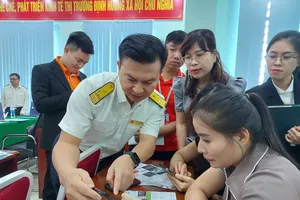
The Ministry of Planning and Investment (MPI) sent an express dispatch to ministries to collect ideas on the socio-economic plan for the Van Don Economic Zone by 2030 with a vision to 2050.
The document asked ministries to join a planning evaluation council and quickly submit opinions on the plan to the Prime Minister for approval.
Earlier, the provincial People’s Committee submitted a document to the PM and MPI about the master plan for approval.
According to the plan, the Van Don Economic Zone is targeting becoming a green, smart and modern island urban area with a focus on logistics, high-end tourism and modern entertainment. It will have a casino and a centre for start-ups and international trade in the China-ASEAN economic corridor.
The EZ would have a sustainable social and economic foundation by 2030 under the master plan. It would be a centre of high quality labour and one of the most liveable cities in the Asia-Pacific region by 2050.
Specifically, the EZ would reach Gross Regional Domestic Product (GRDP) of $1.98 billion and GRDP per capita of $12,242 in 2030, which would be four times higher than the expected level in 2020.
The province said the EZ could create jobs for 106,000 people by 2030, including 37,000 jobs in the tourism sector; 7,000 in service; 14,000 in production and logistics and 48,000 in other sectors.
The Van Don EZ was expected to become one of the most famous cities in the world and a gateway to the northern region of Vietnam. By 2050, the EZ’s GRDP would reach more than $21.8 billion and GRDP per capita would be $43,688 with a population of 501,000 people.
The master plan also said the EZ would base its growth on three main pillars of tourism, cultural services and innovation and production and logistics. These sectors would contribute 82.1 percent of its total GRDP and 70 percent of its jobs by 2050.
Van Don targets developing high-class eco-tourism. It plans to develop casino entertainment services, 3-5 star hotels, spiritual tourism and marine tourism packages.
In addition, it will develop aviation transportation and logistics to become a logistics hub for the country.
The provincial People’s Committee said it targeted building helipads on Cai Bau, Quan Lan and Thang Loi islands. Meanwhile, it would develop seaport to serve tourism and goods transport.
Under the plan, Van Tien bridge will be built to connect the EZ with the Tien Yen Economic Zone, completing the Ha Long-Mong Cai expressway. A high speed rail will connect the EZ with other regions both inside and outside the country. The EZ will also build a metro line in the 2030-2050 period.
The province will mobilise investment from all economic sectors including the State budget, the private sector and foreign direct investment. It has seen private sector investments from Sun Group, FLC, CEO, MBland, Crystal Bay and HD Mon.
The document asked ministries to join a planning evaluation council and quickly submit opinions on the plan to the Prime Minister for approval.
Earlier, the provincial People’s Committee submitted a document to the PM and MPI about the master plan for approval.
According to the plan, the Van Don Economic Zone is targeting becoming a green, smart and modern island urban area with a focus on logistics, high-end tourism and modern entertainment. It will have a casino and a centre for start-ups and international trade in the China-ASEAN economic corridor.
The EZ would have a sustainable social and economic foundation by 2030 under the master plan. It would be a centre of high quality labour and one of the most liveable cities in the Asia-Pacific region by 2050.
Specifically, the EZ would reach Gross Regional Domestic Product (GRDP) of $1.98 billion and GRDP per capita of $12,242 in 2030, which would be four times higher than the expected level in 2020.
The province said the EZ could create jobs for 106,000 people by 2030, including 37,000 jobs in the tourism sector; 7,000 in service; 14,000 in production and logistics and 48,000 in other sectors.
The Van Don EZ was expected to become one of the most famous cities in the world and a gateway to the northern region of Vietnam. By 2050, the EZ’s GRDP would reach more than $21.8 billion and GRDP per capita would be $43,688 with a population of 501,000 people.
The master plan also said the EZ would base its growth on three main pillars of tourism, cultural services and innovation and production and logistics. These sectors would contribute 82.1 percent of its total GRDP and 70 percent of its jobs by 2050.
Van Don targets developing high-class eco-tourism. It plans to develop casino entertainment services, 3-5 star hotels, spiritual tourism and marine tourism packages.
In addition, it will develop aviation transportation and logistics to become a logistics hub for the country.
The provincial People’s Committee said it targeted building helipads on Cai Bau, Quan Lan and Thang Loi islands. Meanwhile, it would develop seaport to serve tourism and goods transport.
Under the plan, Van Tien bridge will be built to connect the EZ with the Tien Yen Economic Zone, completing the Ha Long-Mong Cai expressway. A high speed rail will connect the EZ with other regions both inside and outside the country. The EZ will also build a metro line in the 2030-2050 period.
The province will mobilise investment from all economic sectors including the State budget, the private sector and foreign direct investment. It has seen private sector investments from Sun Group, FLC, CEO, MBland, Crystal Bay and HD Mon.
























